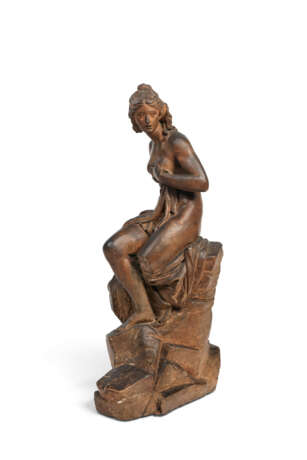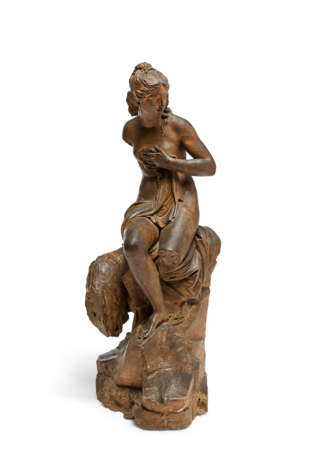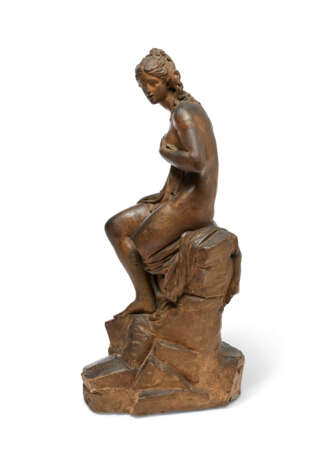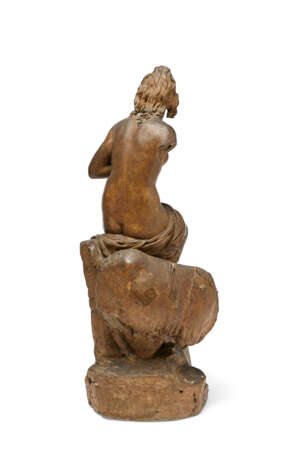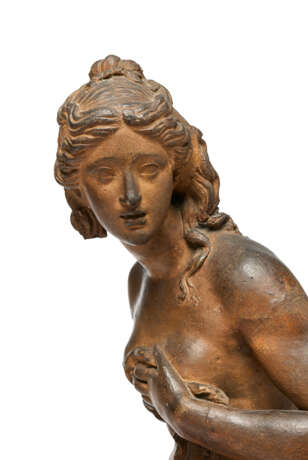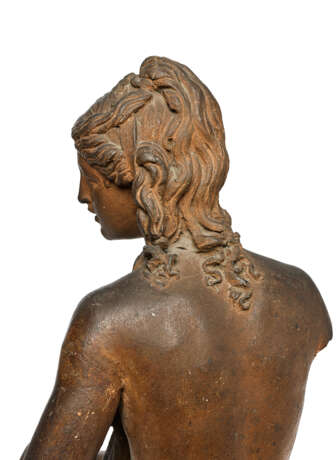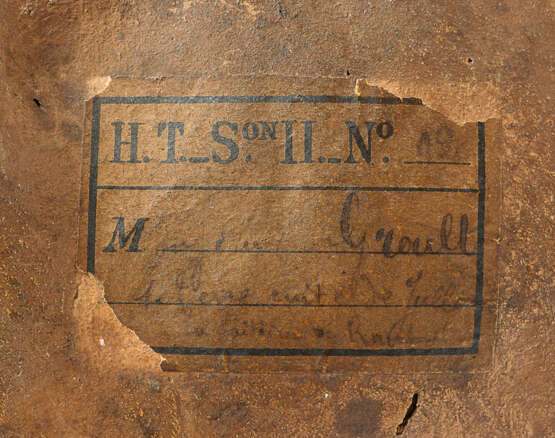ID 1389995
Los 80 | PIERRE JULIEN (1731-1804)
Schätzwert
€ 80 000 – 120 000
Amalthée et la chèvre de Jupiter
terre cuite, porte une étiquette de l'Exposition universelle de 1889 à Paris "H.T. [Palais Historique du Travail], Son. II [Section II], N° 02 / Monsieur Groult / 1 terre cuite de Jullien / La Laitière de Rambouillet" ; accidents et manques
H. 53 cm (21 in.)
Provenance
Collection Charles-Camille Groult (1832-1908).
Vente Me Etienne Ader, Paris, 28 juin 1954, lot 104.
Vente Boisgirard-Antonini, Paris, 6 novembre 2017, lot 144.
Literature
M. P. Worley, « Catalogue of the works of Pierre Julien », in Gazette des Beaux-Arts, VIe période, Tome CXII, 130e année, novembre 1988, p. 195, cat. 28e.
M. P. Worley, Pierre Julien: Sculptor to Queen Marie-Antoinette, 2003, p. 91.
Bibliographie comparative :
G. Grandjean, G. Scherf, Pierre Julien : Sculpteur du roi, Paris, 2004, pp. 66-89.
A. Heitzmann, « La laiterie de Rambouillet » in Versalia, Revue de la Société des Amis de Versailles Année, n°10, 2007, pp. 46-57.
A. Maës, La Laiterie de Marie-Antoinette à Rambouillet : un temple pastoral pour le plaisir de la reine, Paris, 2016, pp. 31-39.
A. Maës, « La Laiterie de la Reine à Rambouillet : "Temple du lait" et demeure d'Amalthée » in G. Wick, R. Serrette (dir.), Vivre à l’antique de Marie-Antoinette à Napoléon 1er , Paris, 2021, pp. 135-147.
Exhibited
Exposition universelle de 1889 à Paris, « Palais de l’Histoire du Travail » [Palais des Arts Libéraux], Section II, Sculptures en terre cuite, Salles H.-I, vitrine 32 à 36, cat. n° 02.
Further details
A TERRACOTTA STUDY OF 'AMALTHEA AND THE GOAT' FOR THE MARBLE GROUP AT QUEEN MARIE-ANTOINETTE'S DAIRY AT THE CHÂTEAU DE RAMBOUILLET, BY PIERRE JULIEN
From 1785, a year after the purchase of the Château de Rambouillet, Louis XVI devised a renovation to reconcile Marie-Antoinette with this hunting estate, whose "gothic" appearance she disliked (Antoine Maës, 2016, p. 12). The initial plan for a new neoclassical château being too costly, the king entrusted his Director of the King's Buildings, the Count d'Angiviller, with the redesign of the park and the creation of a dairy, similar to that at Trianon. As early as the 16th century, Marie de Médicis had such garden follies constructed, followed by Louis XIV in his Ménagerie at Versailles and the Prince de Condé at Chantilly. However, the true growth and enthusiasm for these ornamental structures became evident during the second half of the 18th century, concurrent with the development of English-style gardens. "Les dames venaient [y] prendre le lait, battre le beurre, & faire des fromages pour se délasser (…) des amusements champêtres" (Jacques-François Blondel, Cours d’Architecture, 1773) in the working dairies, while the ornamental dairies served as meeting places and tasting rooms, akin to veritable "temples of milk." The Queen's Dairy at Rambouillet stands at the intersection of admiration for a picturesque way of life and the archaeological rediscoveries initiated at the beginning of the century.
Hubert Robert, painter and designer of the King's gardens, was responsible for the architectural uniformity of this white sandstone setting, erected in 1786, while the architect Jacques-Jean Thévenin drew up the plans. Drawing inspiration from ancient models, the Dairy borrows its formal vocabulary from Roman constructions, particularly the rotunda of the Baths of Diocletian. The decor, for its part, revisits the pastoral theme through six medallions, two friezes, and a marble group commissioned from the sculptor Pierre Julien. These sculptures are complemented by a complete set of "Etruscan" style mahogany furniture by the cabinetmaker Georges Jacob and a porcelain service from the Sèvres manufacture. The group of Amalthea is the central element of this brilliant neoclassical ensemble, integrated into an impressive artificial rock made of Vergelé stone, still visible today, and accompanied by an ingenious hydraulic system.
Julien, a student of Guillaume II Coustou, studied at the French Academy in Rome from 1768 to 1773 before being admitted and received into the Academy in 1778 and 1779. Though ailing in Lyon, the sculptor responded to Hubert Robert's solicitation for the Count d'Angiviller in a letter dated November 29, 1785: "J’espère, Monsieur, pouvoir vous donner bientôt des preuves de mon zele en vous adressant, si vous le desiréz, les esquisses de l’ouvrage de Rambouillet, je vous supplieray de me faire passer les observations qui vous seront dictées par la sureté de votre goût, et l’étendüe de vos lumieres" ("I hope, Sir, to soon provide you with proof of my zeal by sending you, if you so wish, the sketches of the Rambouillet project. I would beseech you to share with me the observations that will be dictated by the surety of your taste and the extent of your knowledge.") (op. cit. p. 31). Despite the short deadline for this commission, the King's sculptor returned to his Parisian workshop and produced these models within a few months. The masterpiece, the group of the nymph Amalthea, nurse of Jupiter accompanied by the goat whose milk nourished the young god (Ovid, The Fasti, chapter V), perfectly matches the iconographic program of the folly. The Louvre Museum preserves a preparatory sketch (inv. RF 2309) as well as the completed marble work (inv. CC 230), considered by Joachim Lebreton, member of the National Institute of Art History, as "la plus gracieuse statue de femme que les modernes aient produite. ("The most graceful statue of a woman that the moderns have produced.")
Our present sculpture undoubtedly represents an unprecedented stage in Pierre Julien's production process, between the sketch, the plaster, and the finished work. This hypothesis is strongly reinforced by the high quality of execution, the finesse of the treatment, and the precision of the details of this terracotta. Originating from the famous collection of the industrialist Camille Groult (1832-1908), the statuette was exhibited, as indicated by its label, at the 1889 Exposition Universelle Internationale in Paris (cat. 02), before being sold at Drouot in 1954 and reappearing on the French art market in 2017. Although other terracotta and plaster examples of Julien's Amalthea exist, only our figure is rendered in these dimensions.
| Angewandte Technik: | Töpferei |
|---|---|
| Material: | Keramik, Terrakotta |
| Genre: | Mythologische Malerei |
| Herkunftsort: | Westeuropa, Frankreich, Europa |
| Kategorie des Auktionshauses: | Skulpturen, Statuen & Figuren |
| Angewandte Technik: | Töpferei |
|---|---|
| Material: | Keramik, Terrakotta |
| Genre: | Mythologische Malerei |
| Herkunftsort: | Westeuropa, Frankreich, Europa |
| Kategorie des Auktionshauses: | Skulpturen, Statuen & Figuren |
| Adresse der Versteigerung |
CHRISTIE'S 9 Avenue Matignon 75008 Paris Frankreich | ||||||||||||||
|---|---|---|---|---|---|---|---|---|---|---|---|---|---|---|---|
| Vorschau |
| ||||||||||||||
| Telefon | +33 (0)1 40 76 85 85 | ||||||||||||||
| Fax | +33 (0)1 40 76 85 86 | ||||||||||||||
| Nutzungsbedingungen | Nutzungsbedingungen | ||||||||||||||
| Versand |
Postdienst Kurierdienst Selbstabholung | ||||||||||||||
| Zahlungsarten |
Banküberweisung | ||||||||||||||
| Geschäftszeiten | Geschäftszeiten
|
